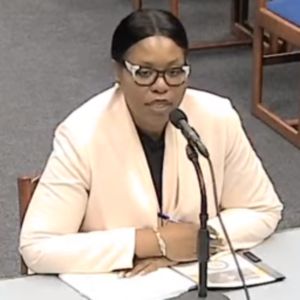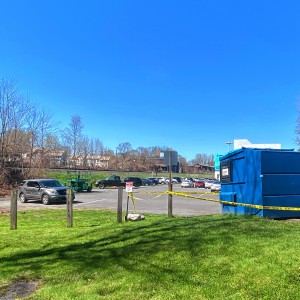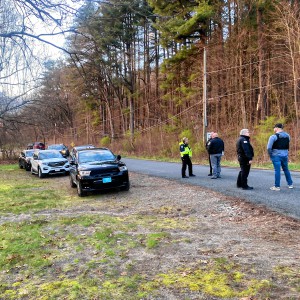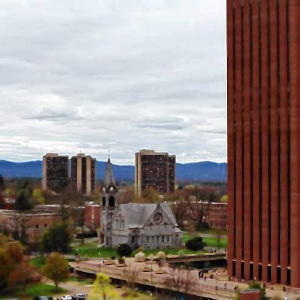At risk: Eight dams in Hampshire/Franklin counties at threat to fail as a warming climate brings bigger storms
| Published: 07-25-2023 2:13 PM |
In July 2021, heavy rainfall caused a beaver dam to burst, leading to the collapse of a 20-foot-long portion of East Street in Belchertown and causing property damage to nearly half a dozen homes.
While the beavers faced the brunt of the blame, according to Christine Hatch, a professor and hydrologist at UMass Amherst, the problem was less about the beavers and more about human-made infrastructure.
“What did fail was the road,” Hatch said. “The culvert was too small, it clogged, water swirling around, it eventually ate away the road base, cut out the culvert and then drained catastrophically right into someone’s yard.”
“Much infrastructure would be hard pressed to withstand that. And so the question is: What was the standard that the infrastructure was built for?” Hatch said.
The answer to that question is what some towns in western Massachusetts are now contemplating after recent storms and flooding put a strain on antiquated dams and infrastructure.
According to the National Inventory of Dams, a federal database that documents dams across the country, about 200 Massachusetts dams are at risk of failing. Among those are nearly 10 in Hampshire and Franklin counties, including Factory Hollow Dike in Amherst, D.F. Riley Grist Mill Dam in Hatfield, Standish Chard and Whitmore Pond dams in Sunderland, Dudleyville Pond Dam in Shutesbury, Beaver Lake and O’Brien Pond dams in Ware, and Forge Pond Dam and Dike in Granby.
All of those dams fall under the category of “significant hazard potential,” which means that if the dam were to fail, loss of human life is unlikely, but environmental damage, economic loss and disruption of lifeline facilities is possible.
Each of the dams is given a condition assessment. Dams in Hatfield, Amherst, Sunderland, Ware and Granby are categorized as “poor,” meaning that safety deficiencies exist and investigations and studies are necessary. The dam in Shutesbury is described as “unsatisfactory,” which indicates that immediate or emergency action must be taken.
Article continues after...
Yesterday's Most Read Articles
 Homeless camp in Northampton ordered to disperse
Homeless camp in Northampton ordered to disperse
 The Iron Horse rides again: The storied Northampton club will reopen at last, May 15
The Iron Horse rides again: The storied Northampton club will reopen at last, May 15
 Final pick for Amherst regional superintendent, from Virgin Islands, aims to ‘lead with love’
Final pick for Amherst regional superintendent, from Virgin Islands, aims to ‘lead with love’
 Authorities ID victim in Greenfield slaying
Authorities ID victim in Greenfield slaying
 Reyes takes helm of UMass flagship amid pro-Palestinian protests
Reyes takes helm of UMass flagship amid pro-Palestinian protests
 Police report details grisly crime scene in Greenfield
Police report details grisly crime scene in Greenfield
As climate change continues to heat up the atmosphere, heavy storms like the ones New England saw over the last two weeks are going to become more common, putting even more stress on dams, experts said.
“This storm was not unique in the sense that it’s not going to happen again,” Hatch said. “This is the direction we’re going, which is that the air is warmer, it holds more water, so for exactly the same size storm … that storm is now going to drop a lot more rain in the same amount of time.”
When dams were designed, many of them over 100 years ago, no one knew that they would face conditions caused by a warming climate.
“That infrastructure wasn’t built for flows this high,” Hatch said. “The age of the infrastructure matters, the condition of the infrastructure matters, how well it’s maintained matters.”
Some of the oldest dams are doing nothing more than clogging up waterways, although “they also make, in some cases, some really pretty lakes that we’ve gotten awfully used to living next to,” Hatch said.
One solution, according to Hatch, is to get dams up to the “aquatic organism passage standard,” which essentially leaves extra room for logs, sticks, fish, mud, sediment and even water to pass.
“If we replace them to the aquatic organism passage standard, which is lovely for the ecosystem and allows the fishes and turtles and everybody to cross underneath, it also makes the whole structure much more resilient to passing these kinds of large storms,” Hatch said.
Part of the solution, Hatch said, has nothing to do with dams, but with the infrastructure around rivers.
Low-lying flat areas next to rivers, called floodplains, work to slow water down when the river rises above its bank. When roads and other impervious surfaces are installed on floodplains, water accumulates and almost immediately runs off pavement, causing quick flooding.
Connecting floodplains and keeping them open so they can do their job “goes a long way to keeping us safe,” according to Hatch.
Others advocate for removing dams altogether. Dam opponents say that dams are problematic for ecosystems and wildlife, while others say that dam removal runs the risk of releasing contaminants that have built up over time.
Some towns have already addressed the issues with dams.
About a year ago, the Lyman Mill Pond Dam in Southampton was removed after blocking a portion of the Manhan River for nearly 300 years. Among reasons for the dam’s removal were heavier and bigger storms, costs of routine inspections, and environmental and public safety concerns.
In Hatfield, the D.F. Riley Grist Mill Dam is been under debate. As of last year, state officials had asked its owners to take down or repair the dam at their expense.
And a designation of “high hazard potential” at the Puffer’s Pond Dam, also called Factory Hollow Pond Dam, means that the town of Amherst must maintain an emergency action plan in case of dam failure, per the state Department of Conservation & Recreation’s Office of Dam Safety.
To begin to address the backlog of inefficient dams, the Healey-Driscoll administration recently announced over $5.6 million in grants for dam repairs and coastal infrastructure for 21 municipalities and nonprofits.
Granby’s Forge Pond Dam and Dike, which was identified as being in “poor” condition, received $75,000 for preliminary design and investigation.
Town Administrator Christopher Martin said the grant money will go toward initial design of potential repairs to the dam, which will take six to nine months.
“We’re looking at trying to repair it and bringing it up to current standards because right now it has a deficiency level with the Office of Dam Safety,” Martin said.
The Select Board, in consultation with Lenart Consulting Service, will determine whether to remove, repair or replace the dam. Martin said the town will likely not remove the dam completely.
An inspection report from 2020 detailed recommendations, which Martin said was the first assessment for repairing the dam. Recommendations included repairing the dam’s concrete walls, filling a depressed area, establishing a grass surface on the dam’s crest, and repairing the gate, among other items.
Once the Select Board works with the consulting firm to assess design and construction needs, the board will apply for a construction grant and begin repairs.
“We are excited about it, and we think it’s one of the best things the town can do right now,” said resident Dori Gaulin, a member of the Friends of Forge Pond, which has been advocating for dam repairs for around five years. “This is a beautiful pond and well worth investing our time and money.”
Gaulin said residents who live near the pond have been advocating for dam repairs because it would keep their wells active. Moreover, dam repairs would benefit wildlife, which would be a help to fishermen who use the pond, she said.
Another Healey grant in the amount of $250,000 went to Northampton for the Francis P. Ryan Reservoir Dam and the West Whately Reservoir Dam Rehabilitation Project, both of which currently meet dam safety standards, according to the Office of Dam Safety.
“The grant will cover a portion of engineering costs for design of improvements to the dams at Ryan and West Whately Reservoirs,” said Donna LaScaleia, director of public works. “The project will improve embankment and spillway conditions at both reservoirs.”
Currently, the project is in its design and permitting phase, which is expected to continue over the next several months.
Maddie Fabian can be reached at mfabian@gazettenet.com or on Twitter @MaddieFabian.
 Federal probe targets UMass response to anti-Arab incidents
Federal probe targets UMass response to anti-Arab incidents Locking up carbon for good: Easthampton inventor’s CO2 removal system turns biomass into biochar
Locking up carbon for good: Easthampton inventor’s CO2 removal system turns biomass into biochar William Strickland, a longtime civil rights activist, scholar and friend of Malcolm X, has died
William Strickland, a longtime civil rights activist, scholar and friend of Malcolm X, has died
